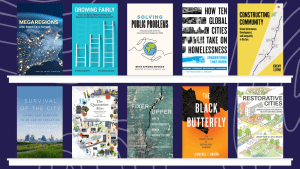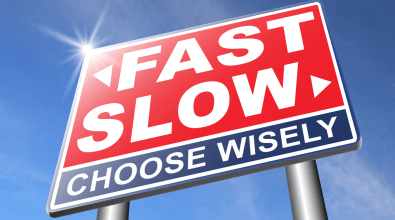10 summer reads for city innovators

Headed out for a break soon and looking for a book to stuff in your suitcase? With a busy vacation season just around the corner, Bloomberg Cities surveyed the latest batch of books on public-sector innovation and urban policy, and also asked city innovators what books they would recommend to their peers. Here are 10 suggestions for engaging reads:
Megaregions and America’s Future
A new book from the Lincoln Institute of Land Policy by Robert D. Yaro, Ming Zhang, and Frederick R. Steiner examines the role of “megaregions” in shaping the future of U.S. policy and planning. The book “explains the concept of megaregions, provides updated economic, demographic, and environmental data, draws lessons from Europe and Asia, and shows how megaregions are an essential framework for governing the world’s largest economy,” writes the Lincoln Institute’s Will Jason. “Megaregions are, in the authors’ view, the perfect geographic unit for channeling federal investment and managing large systems such as interstate rail, multistate natural resource systems, climate mitigation or adaptation, and major economic development initiatives.”
Constructing Community
University of Michigan Professor Jeremy Levine spent four years studying community development in the low-income neighborhoods along Boston’s Fairmount Line commuter train. While politicians often championed these projects, he found many more players than he expected, such as nonprofits and foundations, working on them behind the scenes. As Governing puts it, Constructing Community is “less a study of transit policy than of how ambitious changes get made in an American city, and who really wields influence.”
The Quarantine Atlas: Mapping Global Life Under COVID-19
When COVID-19 first sent much of the world into lockdown, Bloomberg CityLab asked readers to draw and submit maps showing how their lives had suddenly changed. The Quarantine Atlas, edited by Laura Bliss, includes 65 of those maps, along with eight original essays. The result, according to Slate, is “a visual archive of an unprecedented moment of spatial constraint, and the way we lived those limits in our homes, neighborhoods, and cities.”
The Black Butterfly: The Harmful Politics of Race and Space in America
The “Black butterfly” that Lawrence T. Brown writes about refers to the racial geography of Baltimore—looking at a map of where Black residents live, in wide swaths of the city’s east and west sides, the pattern resembles butterfly wings. That’s a jumping off point for Brown, a Morgan State University researcher, to examine the roots and impacts of racial segregation in American cities—and offer steps local leaders and others can take to address it.
Survival of the City: Living and Thriving in an Age of Isolation
Two Harvard economists—Edward Glaeser and David Cutler—use the COVID-19 pandemic as a launch pad for a larger discussion of the health-related “demons” that invariably come with urban density. The New York Times writes: “The book explains why cities and their economies were so vulnerable to COVID-19, and offers a blueprint for addressing the vast disparities in health and economic mobility that the events of the past year have thrust into the spotlight.”
Solving Public Problems: A Practical Guide to Fix Our Government and Change Our World
Beth Simone Noveck, the chief innovation officer in New Jersey and director of the Burnes Center for Social Change and The Governance Lab at Northeastern University, offers a step-by-step guide for how today’s public leaders can and must use data, digital technology, entrepreneurial innovation, and community engagement to solve problems.
Fixer-Upper: How to Repair America’s Broken Housing Systems
Creating affordable housing is at the top of the to-do list in virtually every major American city hall—but in the midst of an ongoing pandemic, persistent inflation, and a looming climate crisis, how do policymakers know which levers to pull? Urban economist and author Jenny Schuetz, who is a senior fellow at the Metropolitan Policy Program at the Brookings Institution, “tries to untangle the contradictory incentives at the root of the crisis…weighs the various solutions and adds up the costs of taking steps to right the ship,” Bloomberg CityLab writes.
Growing Fairly: How to Build Opportunity and Equity in Workforce Development
Authors Stephen Goldsmith and Kate Markin Coleman offer “ten principles for designing a more effective and equitable system that helps workers obtain the skills necessary for economic mobility.” San Diego Mayor Todd Gloria writes that the book “presents a uniquely valuable set of principles that can help cities make progress toward a brighter future for all residents, leaving no one behind.”
Restorative Cities: Urban Design for Mental Health and Wellbeing
The COVID-19 pandemic brought with it an accompanying crisis—a tidal wave of stress, pressure, and anxiety that has brought a simultaneous mental health crisis. How can cities help heal this emotional overload? Layla McCay, founder and director of the Centre for Urban Design and Mental Health in London, and Jenny Roe, an environmental psychologist and professor at the University of Virginia, make the case that green spaces, communal gathering areas, and a focus on aesthetic beauty can make a big difference.
How Ten Global Cities Take on Homelessness: Innovations That Work
Linda Gibbs, Jay Bainbridge, Muzzy Rosenblatt, and Tamiru Mammo look at the response to homelessness in ten cities—Bogotá, Mexico City, Los Angeles, Houston, Nashville, New York City, Baltimore, Edmonton, Paris, and Athens—and offer lessons learned that could help other cities. Says the Stanford Social Innovation Review: “Its real-world examples provide digestible and valuable information to the public—especially to advocates who are beginning a vocation in the field."
Read more from Bloomberg Cities on books for urban innovators:
Mitch Weiss on mastering the art of ‘possibility government’
5 Takeaways on tech from the authors of ‘Power to the Public’


